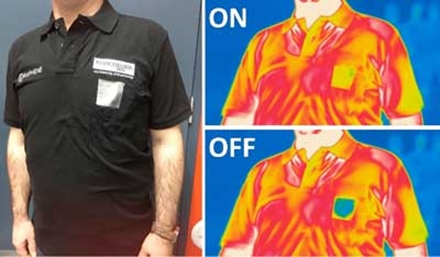|
NOVIDADES
Scientists at the University of Manchester have developed a new type of smart textile that could make its way into adaptive clothing that keeps the wearer cool in warm weather, and vice versa. The material achieves this through the use of graphene which can be tuned to alter the thermal radiation of the textile, with the team imagining the technology could also find its way into advanced displays and even spacesuits. The breakthrough builds on previous work from the same research team, in which they harnessed the incredible abilities of graphene to produce a thermal camouflage to hide a wearer’s heat from infrared cameras. That material worked through a small electrical current that feeds onto layers of graphene embedded in the material.  This prototype garment features a patch of adaptive material on the chest that can be turned on or off to block heat or allow heat it through. University of Manchester
The warmer the human body, the more infrared radiation it emits, so some clothes are designed to allow this radiation to pass through freely to help keep the body temperature low, while others are designed to lock it in to keep the wearer warm. The team has now adapted its smart textile to perform the role of both, with the ability to dynamically transition between these two states via electrical tuning. “Ability to control the thermal radiation is a key necessity for several critical applications such as temperature management of the body in excessive temperature climates,” says Professor Coskun Kocabas, who led the research. “Thermal blankets are a common example used for this purpose. However, maintaining these functionalities as the surroundings heats up or cools down has been an outstanding challenge.” The team demonstrated this dynamic thermal radiation control by creating a prototype garment with the active device featuring as a patch on the chest that could be switched on and off as desired. But the scientists imagine that this capability could be leveraged to serve all kinds of purposes, featuring in interactive displays or even adaptive space suits. In the near-term, the team hopes to explore its potential in addressing the extreme temperature fluctuations facing satellites in orbit. “The next step for this area of research is to address the need for dynamic thermal management of Earth-orbiting satellites,” says said Kocabas. “Satellites in orbit experience excesses of temperature, when they face the Sun and they freeze in the Earth’s shadow. Our technology could enable dynamic thermal management of satellites by controlling the thermal radiation and regulate the satellite temperature on demand.” The research was published in the journal Nano Letters. By Nick Lavars. University of Manchester. Posted: June 19, 2020.
|
|||||||||||||||||||||||||